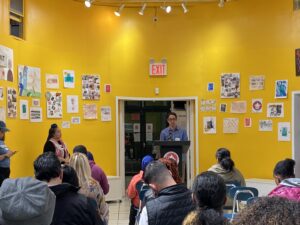Nothing quite excites an office of planners and policy analysts like a once-in-a-generation investment in infrastructure. The passage of the Infrastructure Investment and Jobs Act (IIJA) is worth celebration, both from the folks in the business of building and from the public. In the coming months and years, the mild, yet relatively palpable, current public enthusiasm for potential “infrastructure” will gradually be replaced by the concrete anticipation of an expressway being covered by park space, elevator access in a once inaccessible subway station, or protected bike lanes on a busy urban street. Whether it’s through major construction to improve the built environment, or largely unnoticed upgrades to utilities, this bill will impact every American, in every city and state in the coming years.
On the day President Biden signed IIJA into law, seemingly every piece of journalism took note of his elation: “Finally! Infrastructure week!” In this subtle dig at his predecessor, who failed on the promise to deliver major infrastructure legislation, Biden also reminds us that the inability of politicians to provide on this front has deep roots. Despite dismal evaluations of our roads, bridges, public transportation, and utilities that stretch back decades, the last investment of this scale was nearly 70 years ago—in 1956 with President Eisenhower’s National Interstate and Defense Highways Act.
What took so long?
Despite the overdue need for federal spending, what explains the political gap between promising money for infrastructure and then failing to bring that promise to fruition? Some argue that American democracy is incompatible with a robust infrastructure program, that funds will flow to programs that bring immediate popularity, and not the needed ones that take years to build. There must be some truth in this, but it doesn’t explain why we used to build so big and so well.
A lot has changed, mostly for the best, in the ways that building projects are funded, planned, and eventually constructed since the days when an intercontinental railroad could be built in a matter of years. But maybe it isn’t building practices that make it harder than ever before to fund these projects—maybe it’s the way we talk about them. “Infrastructure week” was likely so long in the making because it is, for most people, totally abstract and boring. The word “infrastructure” just does not convey the exciting audacity of high-speed rail in California. It manages to transform projects that are awe-inspiring in scale into ones that are conceptual, bureaucratic, and “matters of thrifty, dull foresight.” Not once was the Brooklyn Bridge spoken of as an investment in the city’s infrastructure. It was, and still is, a construction and engineering marvel that impacted millions and played a significant role in the city’s history.
The IIJA is steeped in a language that can make its potential abstract and uninspiring. After all, it mostly entails promises for money to be allotted to categories of projects. Among those categories, $110 billion are going to be spent on roads, bridges and other projects and $25 billion for airports. The Infrastructure Investment and Jobs Act isn’t thrilling, but many of its projects almost certainly will be. What follows are some of the exciting, audacious, and enormous projects that this legislation could soon fund in the New York City metropolitan area.
Highways, Roads, and Other Projects
The largest share of funding from this bill, a whopping $110 billion, will be going to projects—highways, roads and “other projects” like bridges and tunnels—to the domain of cars and trucks. For many supporters of transportation alternatives and for those closely following how this bill would fund more sustainable projects, this appeared to be an unfortunate development. Most federal and state infrastructure spending for the last generation has already gone towards projects that enable reliance on personal vehicles and cause pollution. IIJA had the potential to chart a new path forward, to prove that we can get around on high-speed rail and urban public transportation, but on initial glance it doesn’t seem to prioritize projects that make that possible.
But just because there’s a lot of money ear-marked for highways doesn’t mean that it will be spent on expansion or to encourage more commuters to rely on them. In fact, the idea that $110 billion will be spent exclusively to expand the interstate highway system is mostly a myth. Within the category of highways and roads, there are several programs that will be used to make streets friendlier to pedestrians and cyclists, and that encourage commuters to use public transportation.
The Healthy Streets Program is one of the innovative new initiatives that can be found within the category of highway and road spending. This program seeks to address the urban heat island effect, which continues to worsen as a result of climate change and has a disproportionate impact on disadvantaged communities. To do this, over $100 million will be distributed every year through 2026 to projects that improve urban tree canopies and create more porous pavements. In many U.S. cities, tree canopies, which are highly effective for staying cool on the hottest days of summer, are disproportionately found in wealthy neighborhoods. To combat this trend, and to preempt gentrification, those applying to the program will need to specify how the project will benefit disadvantaged and low-income communities, defined as neighborhoods where at least 30% of residents live below the poverty line.
The Infrastructure Investment and Jobs Act doesn’t just put billions of dollars towards the construction and maintenance of streets, it also serves as a catalyst to reconceptualize how they can be used to get around and what their physical presence brings to a community. The last investment of this scale also made an argument about what highways should look like and where they should be placed. And the result was that loud and polluting urban highways disproportionately snaked through low-income communities of color. Planning practices have evolved since the time when these were built, but that doesn’t change the fact that many of these roads continue to be a harmful presence. To address this, nearly $1 billion dollars have been allocated for reconnecting communities that were separated by interstate highways.
The Cross-Bronx Expressway is the epitome of a public works project that caused massive displacement, divided a community, and continues to be a source of noise and air pollution. In fact, the neighborhoods adjacent to the expressway have the highest rates of asthma in the state. A popular proposal to cover much of the highway, which lies in a trench, could finally come to fruition with a share of this funding. Projects like this, and several of the specific funding streams in IIJA, are not only long overdue, but represent a shift in planning philosophy that emphasizes community and environmental impacts. The days of Robert Moses and Dwight Eisenhower era highway construction are hopefully coming to an end, and an active effort to reverse some of the harm they have caused is underway.
Numerous programs in this legislation will serve to transform roads and highways in the coming years: one will fund wildlife crossings over highways while another will specifically support pedestrians and cyclists. Although much of the money in the Infrastructure Investment and Jobs Act will go towards roads and highways, much of that funding will ultimately serve to mitigate their pollution and add safety.
Public Transit for All
Every New Yorker is aware of the pressing need for improving and maintaining the city’s vital network of public transportation. There is a backlog of necessary repairs and upgrades, as well as a list of desirable capital upgrades that are needed to modernize the subway and bus system. The new infrastructure bill creates nearly $39 billion that will be spent on public transit throughout the country. And through various funding streams, the MTA in particular is slated to receive nearly $10 billion to improve and maintain its system.
Several planned and ongoing projects will be guaranteed funding. In the coming years, New Yorkers can finally expect to see more elevators and handicap accessibility in subway stations. The ongoing signal modernization efforts will also certainly continue to replace the 100 plus years old system that controls where trains are. And for major capital improvements, the Gateway project connecting New York’s Penn Station to New Jersey will continue work to replace the crumbling tunnel that is vital to thousands of commuters. For Manhattanites, phase II of the Second Avenue subway will also hopefully avoid additional delays.
Because of ILJA funding, some long sought-after projects could also finally see the light of day. One dream project for many local transportation enthusiasts is the Triboro subway expansion, which would run from Co-op City in the Bronx to Bay Ridge in Brooklyn. The line, which was studied by the Regional Plan Association and is being considered by the MTA, would connect 17 subway and 4 commuter lines and serve as a much-needed alternative to the slow and unreliable bus network on which many commuters in Brooklyn, Queens, and the Bronx rely. Per the proposal, it could be affordably built on land that is already developed for rail access.
Investments in public transportation are a vital component of the legislation’s drive to create a more environmentally sound system for people to get around. These projects will also catalyze economic growth and ensure that everyone can access opportunities in cities.
Participatory Planning – Putting it all in action
Besides transportation, there are so many other types of projects that will be funded through this 2,700-page bill, which promises to invest in high-speed internet, to replace lead piping, to build electric vehicle charging stations, and to cap abandoned oil wells, among many others. While the bill’s abstract nature has not helped to garner the same level of excitement as a Golden Gate Bridge or a Panama Canal, as some major projects enter the planning phase, there are bound to be similar levels of excitement.
Many needed projects that will finally find funding through IIJA will soon enter the planning phase. To ensure that another Cross-Bronx Expressway is not built, there must be robust strategies for community engagement as a vital component of the planning process. A spending spree will soon commence for city and state agencies to improve their infrastructure, and Public Works Partners can aid in the community engagement and financial planning that is vital to ensure long term success. It may finally be infrastructure week, but let’s not forget that the built environment will be around for decades, if not centuries.





 Public Works Partners is a WBE/DBE-certified urban planning and consulting firm. Our expertise lies in creating innovative, equitable, and sustainable solutions to complex problems.
Public Works Partners is a WBE/DBE-certified urban planning and consulting firm. Our expertise lies in creating innovative, equitable, and sustainable solutions to complex problems.